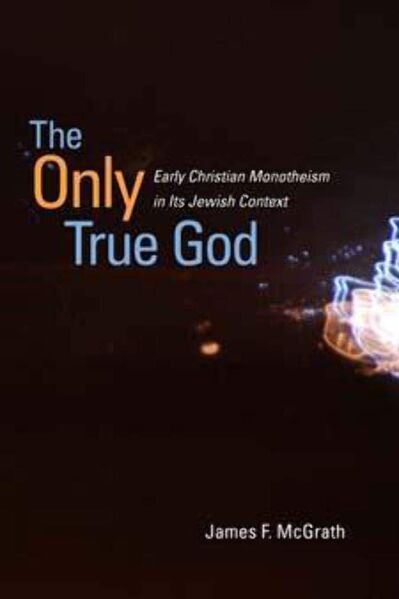File:2009 McGrath.jpg

Original file (666 × 1,000 pixels, file size: 30 KB, MIME type: image/jpeg)
The Only True God: Early Christian Monotheism in Its Jewish Context (2009) is a book by James F. McGrath.
Abstract
"Monotheism, the idea that there is only one true God, is a powerful religious concept that was shaped by competing ideas and the problems they raised. At times, an attempt to enforce exclusive monotheism has divided a people or brought down a ruler; at other times, it has united tribes or peoples who had previously been at war with one another. The concept has been at the focus of many debates among (and between) Christians, Jews, and Muslims. Focusing on the early days of Christianity and its relations to Jewish religion at that time, The Only True God explores the extent to which Christianity began to move in new directions in the earliest period of its history. Surveying New Testament writings and Jewish sources from before and after the rise of Christianity, James F. McGrath argues that even the most developed Christologies in the New Testament fit within the context of first century Jewish "monotheism." In doing so, he pinpoints more precisely when the parting of ways took place over the issue of God's oneness, and he explores philosophical ideas such as "creation out of nothing," which led Jews and Christians to develop differing concepts and definitions about God."--Publisher description.
"In an attempt to nuance our current understanding of the notion of Jewish monotheism, McGrath argues that "monotheism in early Judaism and Christianity meant something other than what it means to many today" and that it was the result of a "complex historical process, wherein many new issues have regularly appeared, and new definitions have been formulated to deal with the new issues" (96). While early Jews did possess a fervent, almost fanatical, adherence to the worship of the only God Most High, the one true God, the literature from this period also attests to a certain blurriness between God and creation that is not fully acknowledged or appreciated. God often shared his agency with other divine beings. Accordingly, these other beings are not only depicted with divine language but they also enact divine functions. They can sit on God's throne or bear God's name without compromising early Judaism's notion of monotheism. Belief in Jesus, like these other divine intermediary figures, did not compromise the Jewish notion of "monotheism" during this time period. Even the claims of the Gospel of John, which explicitly and unequivocally names Jesus as "God (Theos)", does not create a radical shift in early Jewish monotheism. Since "the boundary between God and creation in first-century Judaism was more like a river than a wall" Jesus easily fit within this system (57). Just as Philo can speak of a second God, it is permissible to describe Jesus as a second God. Both Philo and John demonstrate that within the confines of early Judaism "belief in one God who is above all is compatible with belief in a second figure who reveals and represents God" (58). Jesus like Philo's logos is always subordinated to the Father throughout the New Testament. Consequently, it is only in the second and third centuries CE, when the early Church Fathers and the early Rabbis began to define and delineate sharper boundaries between the divine and human realms that Judaism and Christianity can be clearly seen as separating one from the other."~Deborah Forger
Editions and translations
Published in Urbana, IL: University of Illinois Press, 2009.
Table of contents
- 1. Monotheism and method: an introduction to the study of early Jewish and Christian thought about God
- 2. Worship and the question of Jewish monotheism in the Greco-Roman era
- 3. Monotheism and the letters attributed to Paul
- 4. Monotheism and the Gospel of John
- 5. Monotheism and worship in the Book of Revelation
- 6. Two powers heresy: rethinking (and redating) the parting of ways between Jewish and Christian monotheism
- Conclusion
External links
File history
Click on a date/time to view the file as it appeared at that time.
| Date/Time | Thumbnail | Dimensions | User | Comment | |
|---|---|---|---|---|---|
| current | 04:21, 16 April 2024 |  | 666 × 1,000 (30 KB) | Gabriele Boccaccini (talk | contribs) |
You cannot overwrite this file.
File usage
There are no pages that use this file.
- 2009
- Scholarship
- Books
- American Scholarship
- English language
- Made in the 2000s
- Second Temple Studies
- Second Temple Studies--American Scholarship
- Second Temple Studies--English language
- Second Temple Studies--United States
- Christian Origins Studies
- Christian Origins Studies--American Scholarship
- Christian Origins Studies--English language
- Christian Origins Studies--United States
- Monotheism (subject)
- Christology (subject)